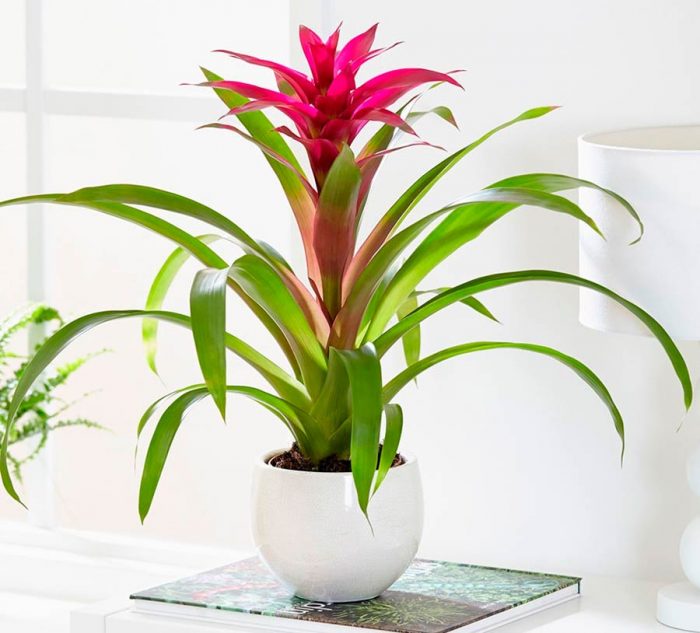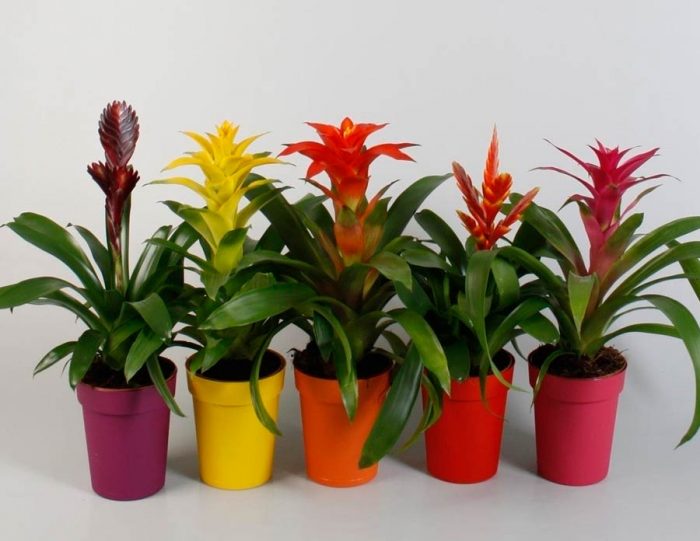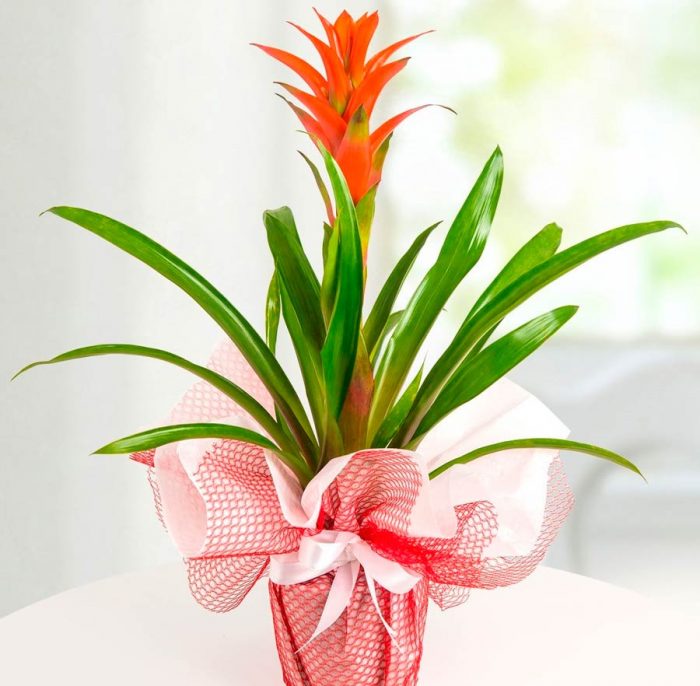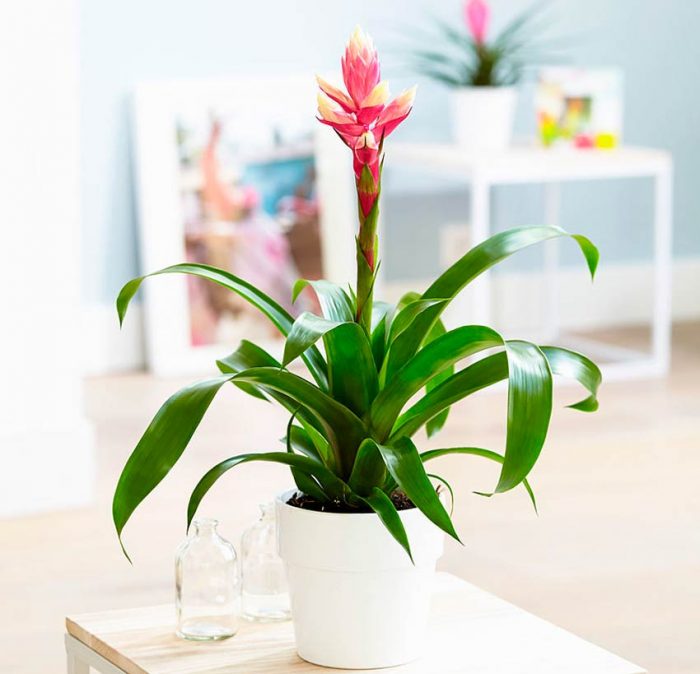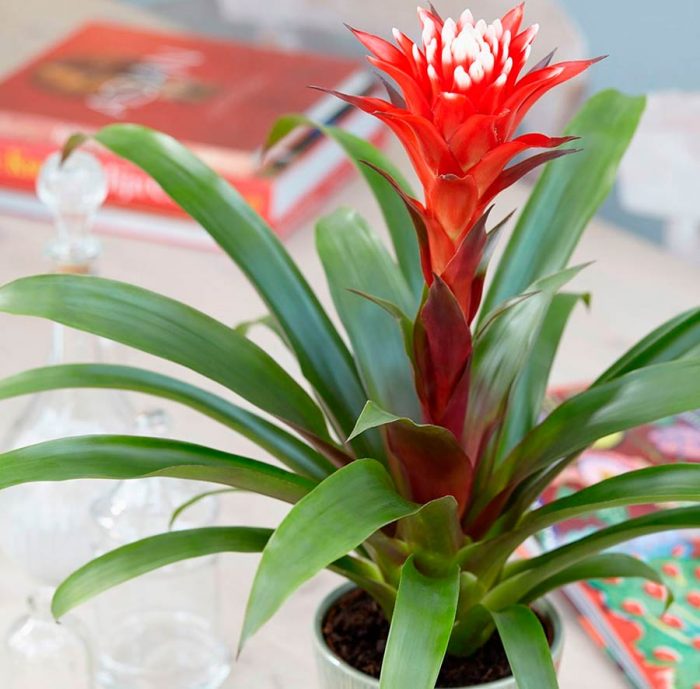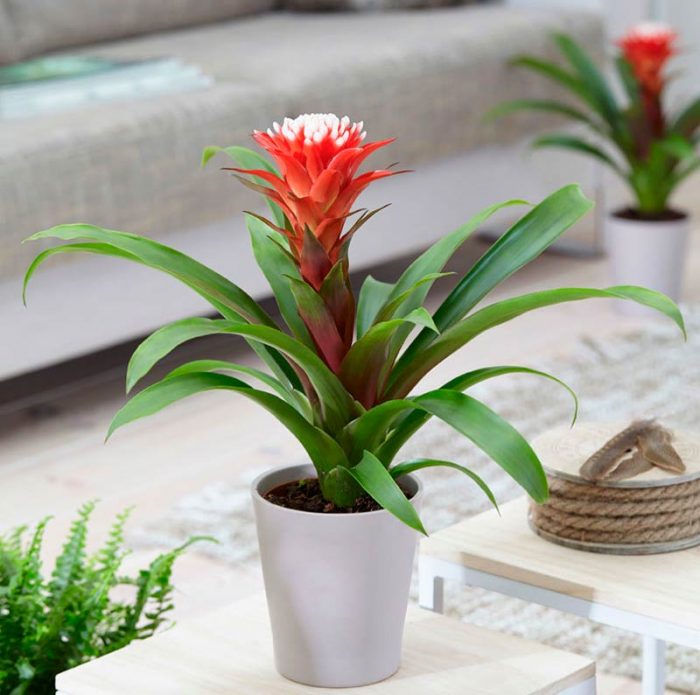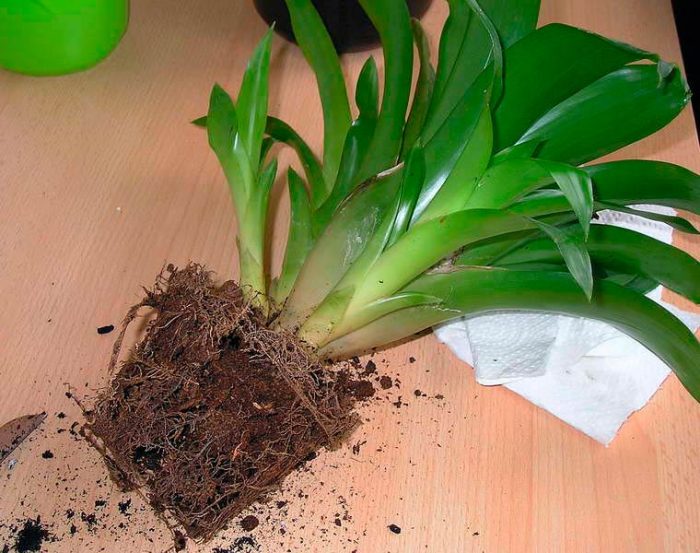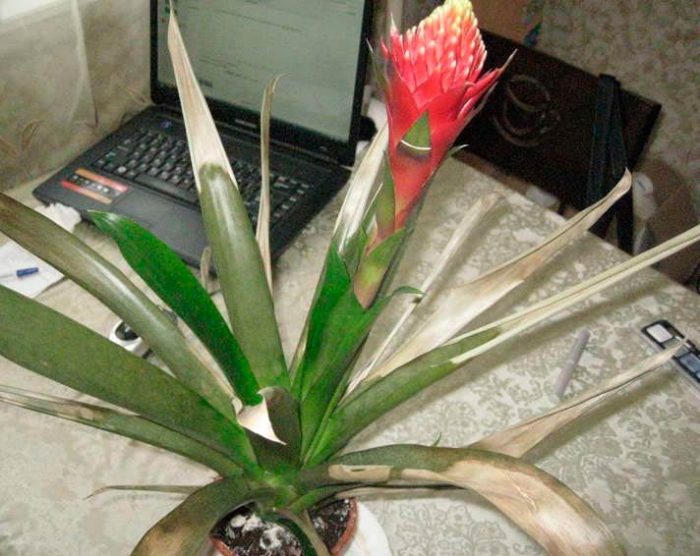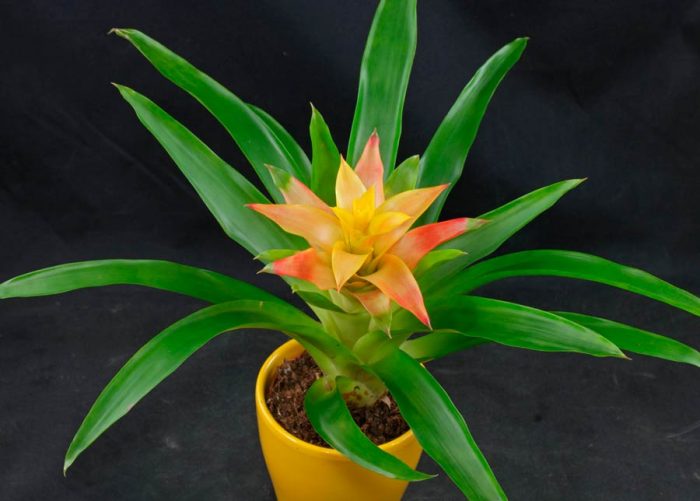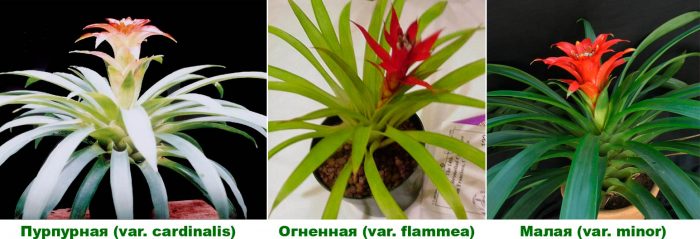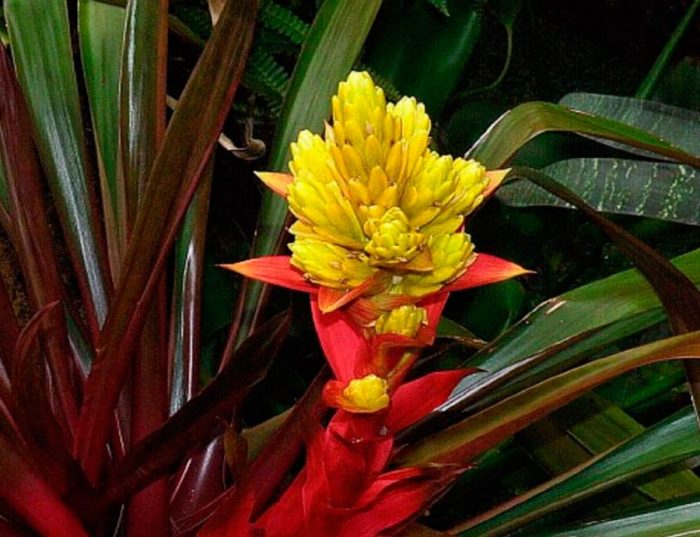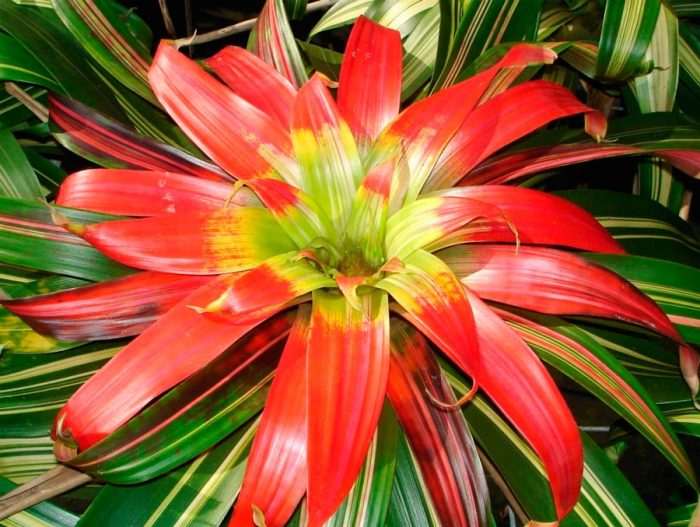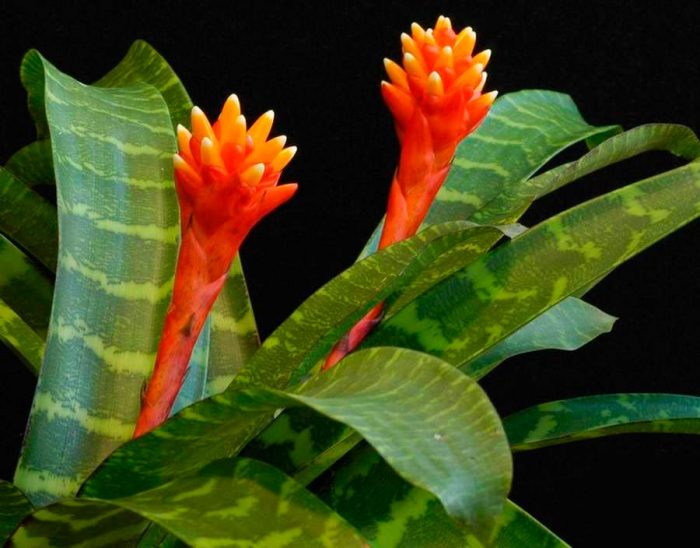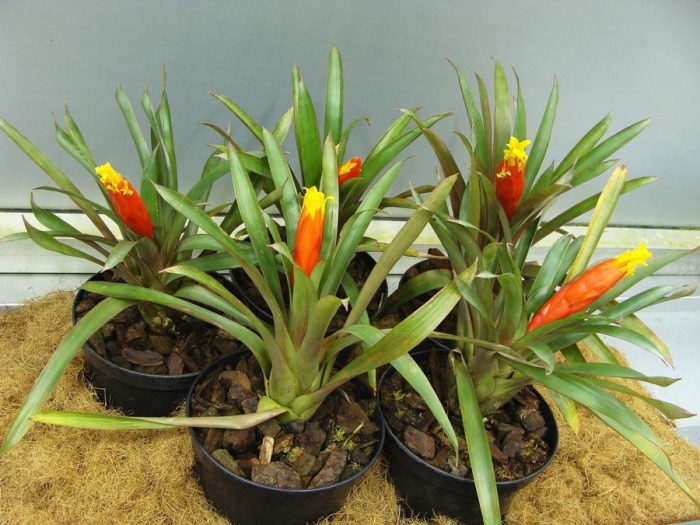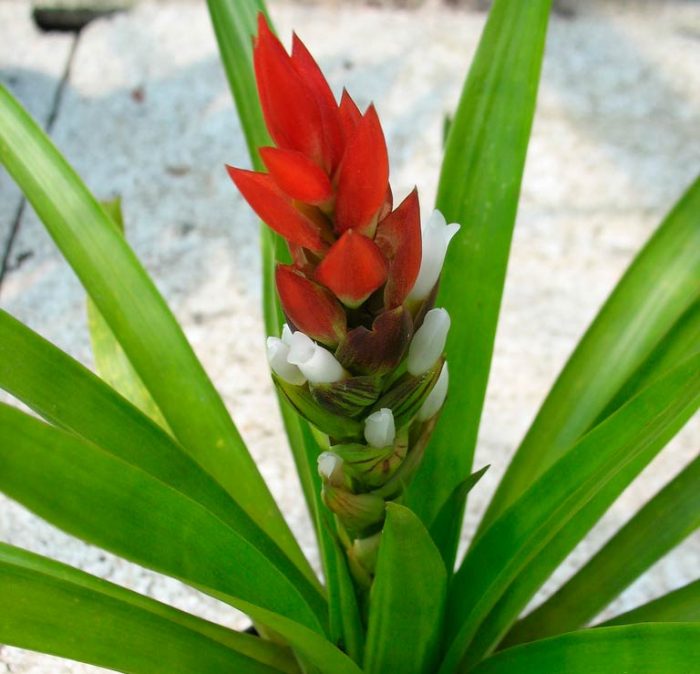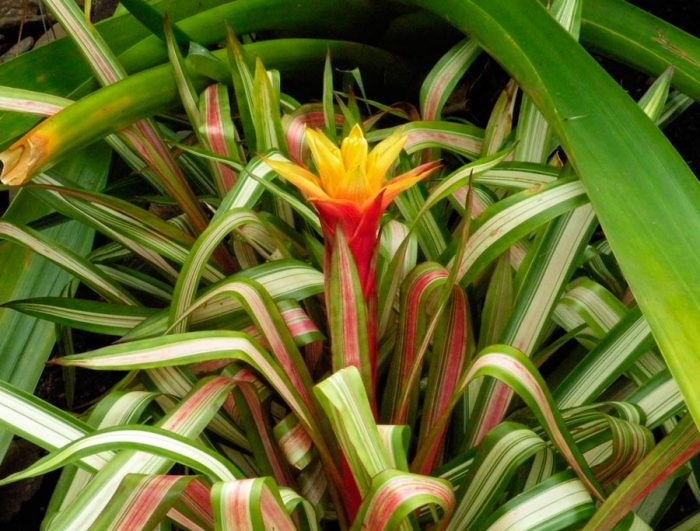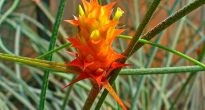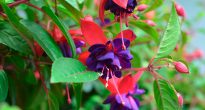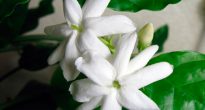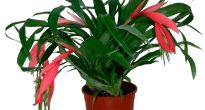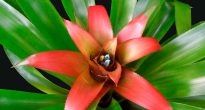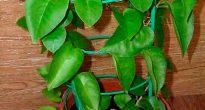The herbaceous evergreen terrestrial or epiphytic plant Guzmania, also called guzmania, is a representative of the Bromeliad family. This genus unites about 130 species. In nature, such plants are found in Brazil, the West Indies, Venezuela, Central America and southern Florida. They prefer to grow on open mountain slopes at an altitude of about 2.4 thousand meters above sea level. In 1802, this genus was described for the first time, and it was named after the Spanish zoologist, botanist, and pharmacist A. Guzman, who studied South America. To date, a large number of species of this plant are grown in indoor conditions. Such a flower has a spectacular rosette, consisting of long leaf plates, and yet not quite an ordinary inflorescence, which resembles a cone in shape. However, the main feature of Guzmania is its long flowering.
Content
Brief description of cultivation
- Bloom... Each of the guzmania rosettes blooms only once, after which it dies.
- Illumination... The light should be bright and diffused.
- Temperature regime... The air temperature should not be above 27 degrees and below - 13 degrees. This flower grows best at a temperature of 25 degrees during active growth and development, and at 20 degrees during the flowering period.
- Watering... It is carried out immediately after the top layer of the soil mixture in the pot dries out a little.
- Air humidity... It should be increased. To do this, the bush is moistened every day from a sprayer with well-settled lukewarm water.
- Fertilizer... Top dressing is carried out from March to September 1 time in 4 weeks, for this fertilizer is used for bromilium, while the concentration of the nutrient solution should be 2 times less than it is written in the instructions.
- Transfer... You do not need to transplant such a flower.
- Reproduction... In rare cases, seeds, and most often lateral processes.
- Harmful insects... Scabbards, mealybugs and spider mites.
- Diseases... Root and gray rot.
Features of guzmania
Like all representatives of the Bromeliads family, in the guzmania, leaf plates at the base are superimposed on each other, forming a semblance of a bowl for water, it accumulates it for itself, but in nature it is also used by other inhabitants of the forest. As a rule, leaf plates are monochromatic, but there are types with transversely or longitudinally striped foliage. The length of the leaf plates varies from 0.4 to 0.7 m, they form a rosette, which, on average, reaches about 50 cm in diameter, however, there are species that are both smaller and more compact. Different types of flower stalks can have different lengths. Flowering begins in March or September and lasts for several months. The flowers are of no decorative value. However, the bracts of the Guzmania are spectacular as if varnished, they are colored yellow, orange, red or white and have a length of 40 to 50 mm. Such bracts form an extremely unusual inflorescence. The height of an adult bush is about 0.75 m, while its width is up to 0.6 m. However, in indoor conditions, the height of such a flower rarely exceeds 0.4 m. After the bush has faded for 6 months, it dies.
Guzmania care at home
To grow guzmania indoors, a florist needs to know how to properly care for her. Such a flower is thermophilic, it grows normally only at high air humidity and it needs bright, but diffused light without direct sunlight.
Temperature regime
The plant, which is preparing for flowering, needs warmth, while the air temperature in the room should not drop below 25 degrees. A flowering bush can be in a cooler place (about 20 degrees). Such a plant can withstand a temperature drop of up to 13 degrees for a short time. Despite the fact that guzmania is thermophilic, it cannot be exposed to high temperatures for a long time (more than 27 degrees), otherwise it can lead to the death of the bush.
Air humidity
In order to maintain the high air humidity required for this flower in the room, it is necessary to moisten it every day from a sprayer, for this you need to use filtered water, but distilled water is better suited for this purpose. In the period from October to February, it is necessary to moisten the flower only in the morning. When spraying the bush, care must be taken that the liquid does not fall on the surface of the bracts, since this significantly reduces the duration of flowering.
Watering rules
For watering and spraying such a plant, you can use only distilled or filtered water, because its root system is extremely sensitive to lime and chlorine. The water must be warm (about 20 degrees). It is necessary to water the flower in such a way that the substrate is always slightly damp. Watering is carried out immediately after the surface of the soil mixture begins to dry out. Water should be poured directly into a leaf outlet. Watering frequency is directly related to the temperature and humidity in the room. If the air temperature and illumination are less than that recommended by experts, then watering will be more rare, but even in this case, it is necessary to moisten the foliage with lukewarm water every day. In the spring-summer period, when the intensive growth of the bush is observed, it especially needs moisture.
Fertilizer
Fertilizer for bromeliads is used to feed Guzmania, which can be purchased at a specialized store. When preparing the nutrient solution, it should be borne in mind that its concentration should be a couple of times less than that indicated in the instructions. Make sure that the fertilizer does not contain copper or boron, as the plant reacts to them extremely negatively. Top dressing is carried out from March to September 1 time in 4 weeks.The nutrient solution is poured directly into a leaf outlet or the bush is moistened with it from a sprayer.
Guzmania transplant
This plant is transplanted only 1 time: from the container in which it grew in the store to its own. But they do this only when it is necessary. The root system of such a plant is small, in this regard, the pot for its transplant should be chosen one that reaches no more than 10-12 centimeters in diameter. Since the bush can turn the pot over as it grows, it must be weighted with something. Also, for stability, the container can be placed in a decorative planter. Don't forget to make a good drainage layer at the bottom of the pot. The soil mixture should pass water well, and its pH should be 5.5–7.0. Approximate soil mixture compositions:
- fern and crushed sphagnum roots (3: 1);
- sand, leafy earth, moss and coniferous bark (1: 2: 1: 2);
- humus, peat, sand and sod land (2: 4: 1: 2).
If you do not want to make up the soil mixture yourself, you can use it ready for orchids or ferns.
Lay a drainage layer at the bottom of the pot and pour a small amount of soil mixture into it, then the bush is transplanted by transferring it from an old container to a new one, while trying not to destroy its earthen lump. Then the prepared soil mixture must be filled in all the voids. At the same time, remember that the roots of the flower are very fragile, so you need to be extremely careful.
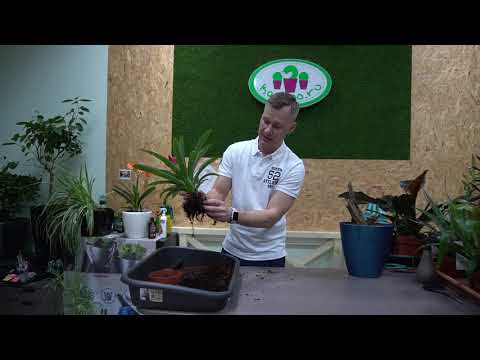

Watch this video on YouTube
After flowering
Each Guzmania bush blooms only 1 time. Experts consider such a plant to be an annual, however, it sometimes takes more than one year to wait until it blooms. The faded bush gradually dies off. If he has children, then they can be transplanted. However, the parent bush will still die.
Reproduction methods
Seating rules
Below, it will be described in detail about the breeding method of guzmania, about dividing a bush and about jigging children. The fact is that all these procedures are identical. After the bush has faded, lateral processes called children are formed. The faded parental rosette dies off over time, however, several lateral processes are formed near it, which eventually form their own root system. The children are deposited after the length of their roots is one and a half centimeters. The baby is cut off from the mother bush with a very sharp pre-sterilized tool, while the places of the cuts both on the appendix and on the old bush are smeared with garden var. The formation of roots at the lateral processes occurs at different rates, in this regard, transplanting them at one time, most likely, will not work. Children are planted in individual pots, which are filled with soil mixture for orchids, after which they are transferred to a warm place. At first, the planted children must be covered with a polyethylene cap from above, since they need constant high humidity. The grown and matured bushes are planted in permanent pots, resorting to the transshipment method, while trying not to injure the fragile roots.
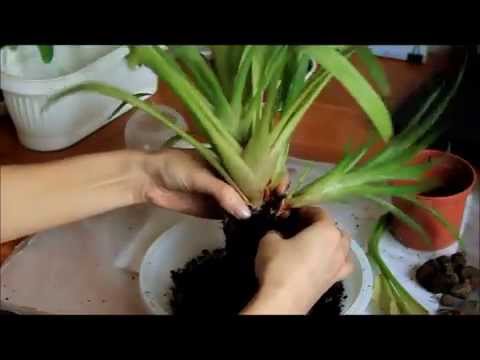

Watch this video on YouTube
Guzmania propagation by seeds
This crop can also be propagated by seed. To begin with, the container is filled with a substrate for bromeliads, which includes sand and crushed peat. The seeds are washed in a solution of potassium manganese, dried well, and then evenly distributed over the surface of the soil mixture. They do not need to be buried in the soil, since they will need a large amount of light for germination, while the surface of the container must be covered with film or glass. Crops are harvested in a warm place (from 22 to 24 degrees), while one must not forget to systematically ventilate them and, if necessary, moisten the substrate from a spray bottle using lukewarm water. The first seedlings should appear after 15–20 days.A pick is carried out after the seedlings are 8-10 weeks old, for this they use a soil mixture, which includes peat, leaf and sod land (4: 2: 1). After half a month after that, the bushes are transplanted into permanent pots. Blooming bushes grown from seeds can be seen in 3-5 years.
Possible problems
- With excessive watering rotting of roots is possible.
- Often guzmania are affected by fungal diseases due to being kept in too warm and humid rooms.
- Brown spots on the leaves indicate sunburn.
- The tips of the leaves turn brown in case of insufficient air humidity, as well as watering with hard water or the lack of the required amount of water in the outlet.
- Plant dying off at the end of flowering - a natural process.
- The appearance of yellow spots on the leaves with a gradual yellowing and death of the leaf as a whole indicates a lesion with a red spider mite.
- The appearance of brown plaques-tubercles on the leaves - the plant is affected by the bromelium scale.
- If the leaves are covered with white cotton wool - means, there was a defeat by mealybugs.
- If the plant does not form daughter, it means he lacks nutrients.
- Drooping and soft leaves indicate a low temperature of the content of guzmania.
Types of guzmania with photos and names
Guzmania reed
In indoor conditions, the most often cultivated guzmania reed is a flower that can grow as an epiphyte and as an epilite (on stony soil). The base of such a plant is a rosette, consisting of long and dense leaf plates of a broad-linear shape and green color, in its middle there is a corolla of inflorescence leaves of a saturated color. Such a corolla can be confused with a flower. Real flowers are part of the spike-shaped inflorescence, but they do not have any decorative value, moreover, flowering does not last very long. This species has several varieties:
- Purple (var.cardinalis)... The spreading rosette includes green leaf plates, the width of which is 30–40 mm. The inflorescence has a red, scarlet or purple color. The inflorescence is multi-flowered. Flowering is observed in March, September.
- Modest (var.concolor)... The rosette consists of greenish leaf plates. The pale orange bracts have a more intense color at the tips.
- Fiery (var.flammea)... The rosette consists of green leaf plates, the length of which is from 24 to 34 centimeters, and the width is from 1 to 2 centimeters, they are directed in all directions of the upper hemisphere. Bracts directed to the zenith are painted in a fiery red hue. Flowering is observed in July, August, while small-flowered inflorescences are formed.
- Plain (var. Lingulata)... The rosette consists of 25 mm wide sheet plates. The color of erect bracts is pink or red. Bloom is observed in March, August and December.
- Small (var. Minor)... The rosette includes green-red or green leaf plates, the width of which is about 25 mm. The inflorescence red or lemon-yellow leaf plates can be spreading or erect.
Guzmania Donnell-Smith
It has a loose rosette consisting of green leaf plates with scales of a paler shade. On an erect peduncle, a short inflorescence of a pyramidal-paniculate shape is formed, which at the base is covered with tiled bracts of a deep red color. Blooming is observed in April, May.
Guzmania blood red
The goblet rosette consists of broad-linear sheet plates. The deep red bracts are thin. The corymbose inflorescence has a leaf-shaped wrapper, its peduncle is undeveloped, therefore it is immersed in a leaf rosette. This species has several varieties:
- Bloody (var. Sanguinea)... Bracts are rounded with a sharp tip. The flowers are white or greenish-yellow. Flowering is observed in April and August.
- Short-legged (var. Brevipedicellata)... Pointed bracts are helmet-shaped.
Guzmania musaika, or mosaic
The spreading rosette is formed from long leaf plates. On the straight peduncle there are sharply elliptical stipules of a deep pink color. A simple capitate inflorescence consists of 20 yellowish-white flowers, its base is hidden by stipules. This species has such varieties as:
- Musaica - greenish leaf plates are lined with irregular lines, flowering is observed in June, September;
- Concolor - monochromatic foliage;
- Zebrina - there are wide stripes on the foliage.
Guzmania Nicaraguensi
The bush has a tongue-like foliage that tapers towards the top, along the lower part it is covered with faded dense scales, which disappear over time. Instead of scales, small longitudinal red streaks form on the foliage. The leaf rosette has a goblet shape, a spindle-shaped simple inflorescence is immersed in it, on which not very many yellow flowers grow. Flowering is observed in March, May.
Guzmania monostachia (Guzmania monostachia)
The rosette contains a large number of greenish-yellow leaf plates, while those that are below are faded compared to the upper ones, and on their surface in some places there is a coating consisting of small-dotted scales, over time they fly around. At the top of the naked peduncle, an elongated multi-row spike grows, consisting of white flowers. In sterile flowers, bracts are white or deep red, and in fruit-forming ones, they are faded with longitudinal risks of brown. There are the following varieties:
- Monostachia - leaf plates are monochromatic, on the faded bracts there are longitudinal streaks of a chocolate shade, flowering is observed in June, July;
- Variegata - there are white streaks on the green leaf plates;
- Alba - the foliage is solid green, the upper bracts are white, and the lower ones are also green.
Guzmania Tsana (Guzmaniazahnii)
The bush has a relatively gigantic size, the length of its leaf plates is about 0.7 m.
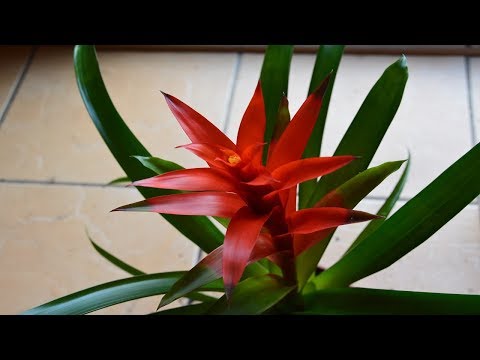

Watch this video on YouTube

